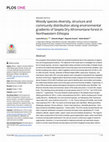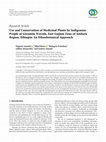Papers by Nigussie Amsalu

Dry evergreen Afromontane forests are severely threatened due to the expansion of agriculture and... more Dry evergreen Afromontane forests are severely threatened due to the expansion of agriculture and overgrazing by livestock. The objective of this study was to investigate the composition of woody species, structure, regeneration status and plant communities in Seqela forest, as well as the relationship between plant community types and environmental variables. Systematic sampling was used to collect vegetation and environmental data from 52 (20 m x 20 m) (400 m2) plots. Density, Diameter at Breast Height (DBH), basal area, frequency, and importance value index (IVI) of woody species were computed to characterize the vegetation structure of the forest. Agglomerative hierarchical cluster analysis and Canonical Correspondence Analysis (CCA) with R software were used to identify plant communities and analyse the relationship between plant community types and environmental variables, respectively. A total of 68 woody plant species belonging to 63 genera and 44 families were identified. The Shannon diversity index and evenness values of the study area were 2.12 and 0.92, respectively. The total basal area and density of woody species were 27.4 m 2 ha-1 and 1079.3 individual ha-1 , respectively. The most frequent woody species in the Seqela forest included Albizia gummifera (51.92%), Croton macrostachyus (44.23%), Olinia rochetiana and Teclea nobilis (36.54%). Additionally, the most dominant species, as indicated by their importance value index (IVI), were Erythrina brucei (IVI = 11.24), Prunus africana (IVI=8.68), and Croton macrostachyus (IVI=7.38). Four plant community types were identified: Albizia gummifera-Ekebergia capensis, Prunus africana-Croton macrostachyus, Vachellia abyssinica-Dombeya torrida and Schefflera abyssinica-Teclea nobilis. The CCA results showed that the variation of species distribution and plant community formation were significantly (P < 0.05) related to altitude, organic matter, aspect, slope and soil available phosphorus. The regeneration status assessment of the forest revealed a good regeneration status, which was linked to diverse and abundant seed bank in the soil can ensure a continuous supply of seeds for regeneration; therefore, it is recommended to implement periodic soil seed bank assessments to monitor seed diversity and abundance and inform targeted conservation actions.
Phytomedicine plus, Jul 1, 2024

African Journal of Medical and Health Sciences, Sep 30, 2020
This work aims to study the potential and importance of wild edible plants (WEPs) as antioxidants... more This work aims to study the potential and importance of wild edible plants (WEPs) as antioxidants in treating different diseases caused by free radicals. A total of 67 species belonging to 50 genera under 36 families and naturally growing in Ethiopia were recorded after assessing all available documents. About 16.2% of the total (413) WEPs were recorded in the country. The plant families with more number of species known to have antioxidants are Amaranthaceae and Moraceae 7 species each. Fruits are the dominant edible parts followed by leaves. Compounds such as tannins, oxalates and phenolic acids are the major contributors to the antioxidant activity of vegetables, fruits and medicinal plants. Plants also have many phytochemicals which are a potential source of natural antioxidants such as phenolic diterpenes, flavonoids, flavonols, alkaloids, iridoids and saponins, High consumption of fruits and vegetables is associated with a lowered occurrence of cancer, heart disease, inflammation, arthritis, neurodegenerative diseases and diabetes. Antioxidant components including vitamin C, vitamin E, carotenoid, and plant polyphenols appeared to play a key role in reducing the development of such diseases. This review gives a general overview of the antioxidant properties of different parts of WEPs in a single volume and ease selection of the best species for further research. The chemical composition, antioxidant contents and energy values of wild plants consumed by Ethiopians indicated that they provide key nutrients such as carbohydrates minerals and vitamins. The plants will be lost along with their valuable nutrients and indigenous knowledge without proper management and conservation in the right places and habitats. Keywords: antioxidant, Ethiopia, health benefit, phytochemicals, wild edible plants.
Addis Ababa University, Jun 6, 2020

Evidence-Based Complementary and Alternative Medicine, 2018
An ethnobotanical study of medicinal plants (MPs) used by the local community has been carried ou... more An ethnobotanical study of medicinal plants (MPs) used by the local community has been carried out from January 5, 2014, to February 15, 2015, in Gozamin Wereda of East Gojjam Zone, Ethiopia. The purpose of this study was to identify and document the use and conservation of MPs, along with indigenous knowledge of Gozamin community. Data were collected using semistructured interview, field observation, and focus group discussions. The collected data were assessed quantitatively using fidelity level, Jaccard’s Coefficient of Similarity, paired comparisons, direct matrix, and preference rankings. In total 93 MPs distributed under 51 families and 87 genera were identified and for each taxon a local name (Amharic) was documented. Asteraceae with 9 (9.68%) species and Solanaceae with 7 (7.53%) species were families represented by more species in the study area. Out of these MPs collected, 80 plant species were used for the treatment of human ailments, 24 species were used against livestoc...

This work aims to study the potential and importance of wild edible plants (WEPs) as antioxidants... more This work aims to study the potential and importance of wild edible plants (WEPs) as antioxidants in treating different diseases caused by free radicals. A total of 67 species belonging to 50 genera under 36 families and naturally growing in Ethiopia were recorded after assessing all available documents. About 16.2% of the total (413) WEPs were recorded in the country. The plant families with more number of species known to have antioxidants are Amaranthaceae and Moraceae 7 species each. Fruits are the dominant edible parts followed by leaves. Compounds such as tannins, oxalates and phenolic acids are the major contributors to the antioxidant activity of vegetables, fruits and medicinal plants. Plants also have many phytochemicals which are a potential source of natural antioxidants such as phenolic diterpenes, flavonoids, flavonols, alkaloids, iridoids and saponins, High consumption of fruits and vegetables is associated with a lowered occurrence of cancer, heart disease, inflammat...

Uploads
Papers by Nigussie Amsalu